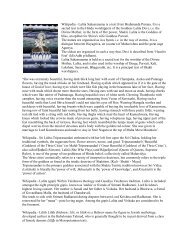Download File - swamiservant
Download File - swamiservant
Download File - swamiservant
Create successful ePaper yourself
Turn your PDF publications into a flip-book with our unique Google optimized e-Paper software.
At the time of Christ, no differentiation was made between medical treatment and exorcism or<br />
miracles, all three were interrelated. To cure someone of a disease or to relieve them of an injury<br />
was paramount to exorcising the tormenting spirit, or miraculously healing them.<br />
Thus it is not so surprising to find that the anointing oil expelled demons and gave protection<br />
against them, correspondingly it cured and dispelled the ‗sickness‘ of the soul and body.<br />
Exorcism (literally ‗driving out‘) was performed by means of anointing. The ancient magical<br />
texts provide abundant evidence for this application of oil. ‘…And they cast out many devils, and<br />
anointed with oil many that were sick, and healed them’. (Mark 6:13)<br />
One of Jesus' most well known miracles is his healing of lepers, which appears in the first three<br />
New Testament Gospels. The term translated as leprosy can actually refer to any number of skin<br />
diseases, usually systemic infectious lesions or extreme allergic reactions.<br />
Due to its topical anti-bacterial properties, cannabis has been used to treat a variety of skin<br />
diseases such as pruritis, also known as atopic dermatitis, an inflammatory skin disorder. The<br />
symptoms of pruritis are severe itching, "and patches of inflamed skin, especially on the hands,<br />
face, neck legs, and genitals," a description that sounds startlingly similar to the skin disease<br />
described in Leviticus 13, called tsara'ath. It is usually translated in the Old Testament as<br />
leprosy, but has been noted by a number of scholars to be more likely a reference to a severe<br />
form of pruritis rather than true leprosy (Hansen's disease).<br />
In relation to Jesus' curing of the lepers (Matthew 8,10,11 Mark 1, Luke 5,7,17), we could have<br />
an example of a disease expelled through the use of the cannabis ‗holy-oil‘. Besides the antibacterial<br />
properties of cannabis oil, cannabis has been said to be effective in treating sufferers of<br />
Pruritis even when administered through smoking!<br />
Evidence of cannabis ointment's topical healing abilities can also be seen in its use as a treatment<br />
for the modern ‗sexual leprosy‘ of herpes. Sufferers of cold sores and genital herpes have<br />
reported successful treatments by soaking cannabis leaves and flowers in rubbing alcohol and<br />
then dabbing the greenish solution on the site of a potential herpetic sore outbreak. ‗They say it<br />
prevents blistering and makes sores disappear in a day or two‘. Direct contact with THC killed<br />
herpes virus in a 1990 research study at the University of South Florida.<br />
A 1960 study in Czechoslovakia concluded that - ‗cannabidiociolic acid, a product of the unripe<br />
hemp plant, has bacteriocidal properties‘. The Czech researchers ‗found that cannabis extracts<br />
containing cannabidiolic acid produced impressive antibacterial effects on a number of microorganisms,<br />
including strains of staphylococcus that resist penicillin and other antibiotics‘. The<br />
Czech researchers successfully treated a variety of conditions, including ear infections, with<br />
cannabis lotions and ointments. Topical application of cannabis relieved pain and prevented<br />
infection in second-degree burns….<br />
The Gnostic Gospel of Philip makes direct reference to how the holy oil ‗healed the wounds‘,<br />
and not surprisingly we find that cannabis was used in salves and ointments for burns and<br />
wounds throughout the middle-ages. Cannabis resin was also used for other topical applications,<br />
especially in relieving the pain of worn and crippled joints. ‗Cannabis is a topical analgesic.<br />
Until 1937, virtually all corn plasters, muscle ointments, and [cystic] fibrosis poultices were<br />
made from or with cannabis extracts‘.<br />
A common and effective home remedy for rheumatism in South America was to heat cannabis in<br />
water with alcohol and rub the solution into the affected areas. In the middle of the 19th century<br />
Dr WB O'Shaughnessy claimed to have successfully treated rheumatism (along with other<br />
maladies), with ‗doses of cannabis resin‘ given orally.



